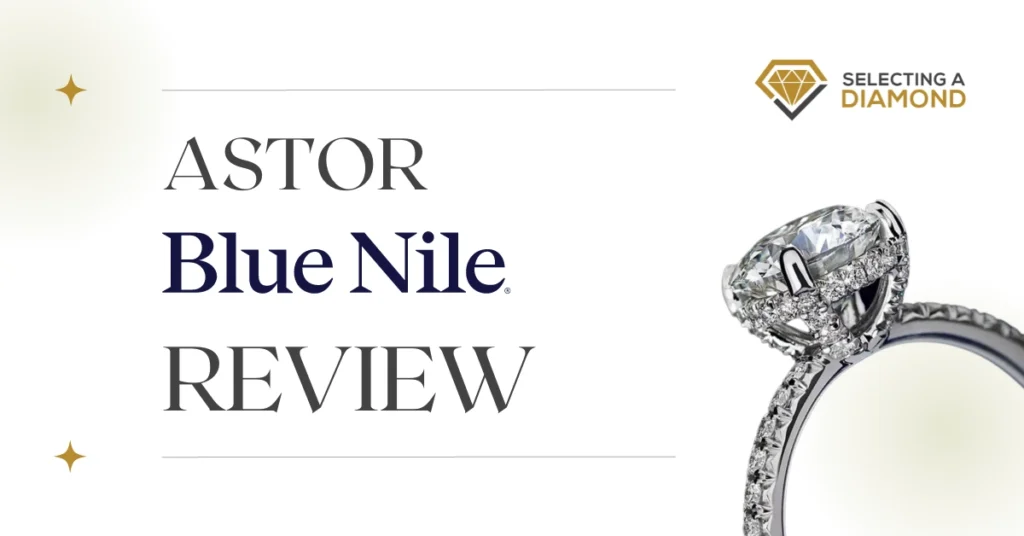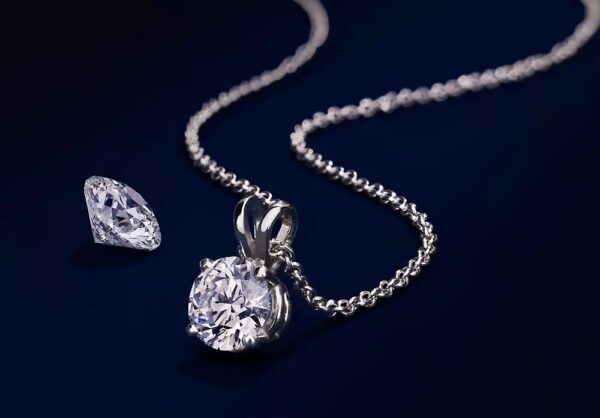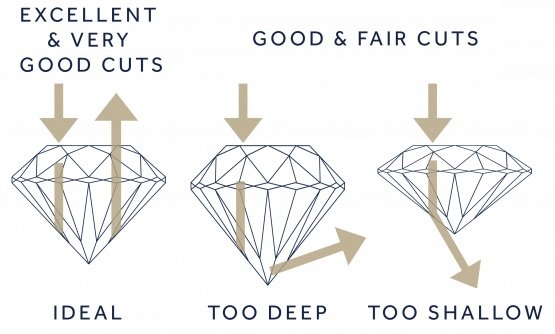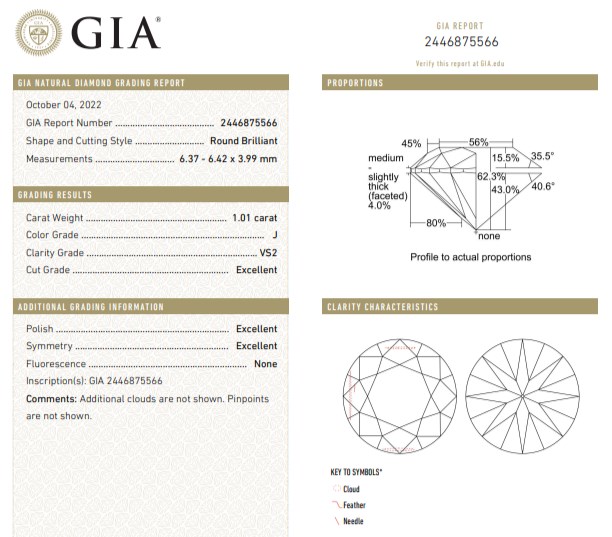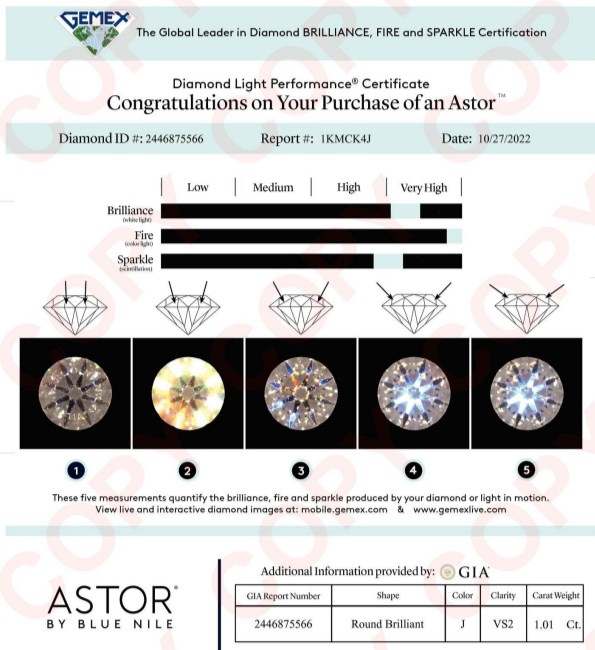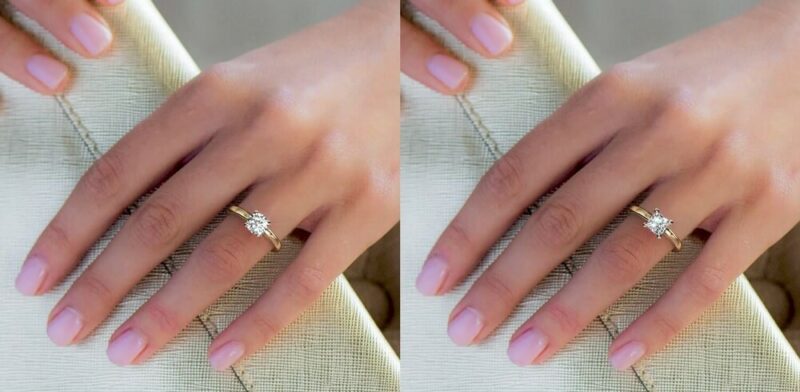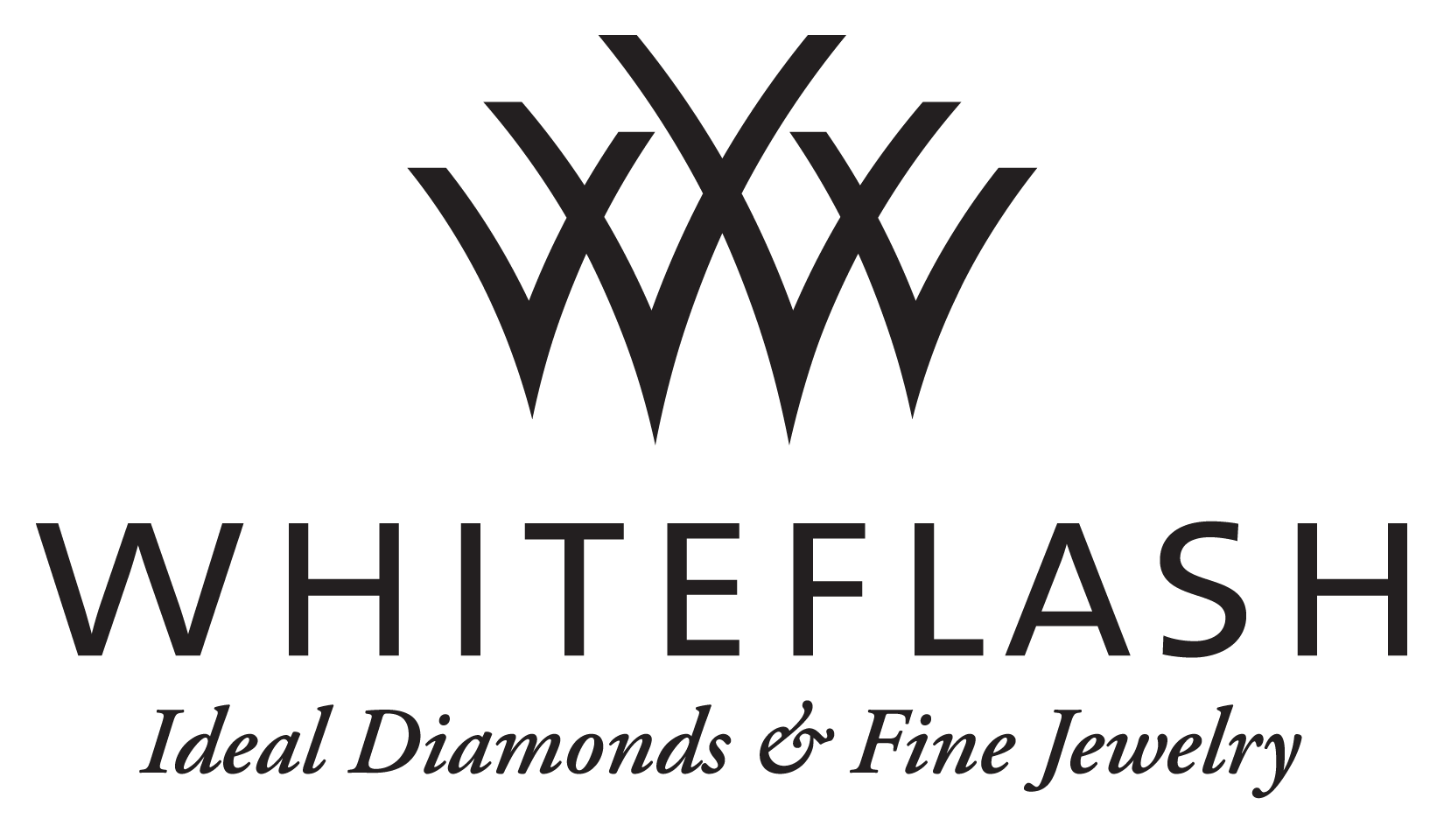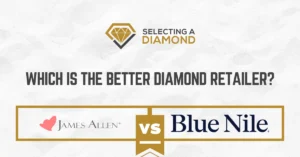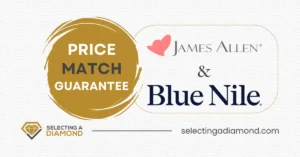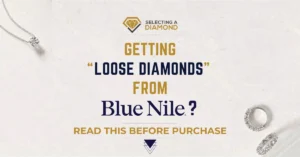We may earn a commission when you purchase through our affiliate links, at no extra cost to you. This helps support our work and allows us to continue providing unbiased, expert diamond advice.
Summary in a few lines…
Astor diamonds flaunt an incredibly superior cut, frequently labeled as “Hearts & Arrows”. Why, you may ask? Under advanced imaging devices, these diamonds reveal a stunning pattern of symmetrical hearts and arrows – a testament to the precision of their cut.
Take, for example, this magnificent G VS2 Astor diamond, a paragon of perfection priced at $10.7k. While this may seem extravagant, even when compared to a diamond of excellent cut, it’s vital to remember the outstanding craftsmanship that defines this diamond.
However, it’s also possible to find Astor diamonds of lower quality, such as this Radiant shaped one. The Astor collection is renowned for its premium cuts, but bear in mind, this doesn’t guarantee other superior features.
In the diamond realm, not all that glitters is gold – or in this case, not every Astor diamond can be recommended without reservations. Some are undoubtedly exceptional, others may lack in certain areas, despite boasting an impressive cut.
So, let’s delve into this exciting world of premium cuts. It’s time to unveil the mystery.
If you’ve spent any time exploring Blue Nile, you’re likely already familiar with their exquisite selection of Astor by Blue Nile™ diamonds. This type of high-quality collection is a common sight on large online diamond retailers. James Allen’s True Hearts™ and Whiteflash’s A CUT ABOVE® are examples of such collections, all offering diamonds with exceptionally high-quality cuts and incredible light reflection.
This naturally leads us to the question – are these premium collections worth their higher price tag? Let’s find out together!
Blue Nile Quick Overview
Most of us are familiar with Blue Nile, the giant in the diamond industry, and although we’ve extensively covered them in a dedicated post, it’s always worthwhile to brush up on a few key points about this colossal retailer:
- Blue Nile, in tandem with James Allen, houses an astonishing inventory exceeding 1 million diamonds, with each store harboring nearly half a million pieces.
- Established in 1999, Blue Nile has been instrumental in reshaping the landscape of online diamond shopping. Without their innovative approach, the current face of online diamond retailing would be vastly different.
- The majority of their collection is showcased with 360-degree imagery, a substantial achievement considering they had no such visuals just three years ago.
- Blue Nile is committed to quality, offering only diamonds that have received grading from the Gemological Institute of America (GIA), and do not deal with American Gem Society (AGS) graded diamonds.
- Keeping pace with current trends, Blue Nile has recently stepped into the realm of lab-created diamonds. Their selection is vast, with over 16k options, all of which are GIA-graded, even the lab-grown ones.
- Beyond diamonds, Blue Nile is reputed for their superior jewelry offerings, presenting a vast array of exquisite pieces at attractive price points
Astor by Blue Nile™ Collection
Prior to September 2017, Blue Nile marketed a range known as the Blue Nile Signature™, claiming it to have Perfect Proportions & Exceptional Symmetry for maximizing brilliance. However, this collection seemingly didn’t quite hit the mark with consumers.
As a response, Blue Nile decided to rebrand, introducing the Signature’s successor, Astor. With this fresh collection, Blue Nile pledges to uphold their commitment to superior quality standards and exceptional value.
Astor by Blue Nile™ diamonds are hailed as “hand-selected, precisely cut, and double certified to mesmerize in ways other diamonds cannot.”
On visiting Blue Nile’s Astor webpage, one is met with descriptors such as “exceptionally rare and extraordinary”, with the diamonds being “cut for optimal brilliance”.
Indeed, Blue Nile assures every piece in the Astor collection will offer a brilliant sparkle and superior cut. However, as we know, a diamond’s cut is only one aspect of the famed 4Cs of diamonds.
So, What Truly Makes a Diamond Spectacular?
The four primary attributes that determine the quality of a diamond are Cut, Color, Clarity, and Carat. Each has its own significance, but it’s universally recognized that the Cut holds the utmost importance.
Therefore, a diamond with an exceptional cut can indeed guarantee a remarkable sparkle.
This illustration highlights the critical nature of an excellent cut diamond:
Nonetheless, what about the remaining three Cs?
We’ll delve into this in a later section, but suffice it to say, it is crucial to ensure that the diamond’s color, clarity, and fluorescence are also within the recommended grades.
Which Shapes are Available in the Astor Collection?
James Allen’s True Hearts is available in three shapes: round, princess, and cushion.
Whiteflash’s A CUT ABOVE is offered in two shapes: round and princess.
Conversely, Astor comes in a whopping six shapes: round, princess, heart, oval, radiant, and cushion.
Food for thought: If the Astor cut is genuinely premium, why does it appear in so many shapes compared to other Hearts & Arrows collections?
Pro Tip: Don’t confuse ‘cut’ with ‘shape’ – while ‘cut’ is often colloquially used to denote ‘shape’, they are distinct attributes.
If you’re interested, check out our Diamond Shape Guide where we discuss the most popular diamond shapes, complete with illustrative images.
How Rare are Astor Diamonds?
Blue Nile remains somewhat vague about the specifics of their Astor collection and the criteria used for their selection.
However, they make a bold assertion: only 1 out of 1000 diamonds have the qualities to be considered for the Astor category, promising each Astor diamond will display exceptional sparkle and brilliance.
Does GIA Certify Astor Diamonds?
This question is incomplete, the correct one should be:
Does GIA certify Astor diamonds AS Astor?
The answer?
Yes as an excellent cut.
No as an Astor!
Let’s decipher how Blue Nile attempts to persuade customers that GIA certifies Astor diamonds.
Blue Nile employs a clever strategy to bolster the credibility of their Astor collection by utilizing certification labels. They state that all Astor diamonds are certified by two labs: GIA & Gemex. However, this information is artfully worded.
In the context of the Astor range, when Blue Nile mentions the well-regarded GIA lab, they do so with care and craftiness.
Their intention is to convince you that these diamonds have been officially endorsed by renowned certification labs. However, if you visit the official Astor page on their site, you’ll notice they use terms like certified, assessed, curated, and analyzed.
While it’s accurate that these diamonds are inspected and certified by GIA, like any diamond worldwide submitted to GIA labs, does the GIA certificate bear the word “Astor”?
Certainly not.
This isn’t an uncommon practice. James Allen does something similar, as we observed during our detailed review of True Hearts™ (Hearts & Arrows) Diamonds by James Allen.
They try to assure you that your diamond is recognized as exceptional by GIA or AGS (for True Hearts) or by GIA (for Astor), but the highest grade you’ll find on the GIA certificate is “Excellent” in the Cut section.
Update: It appears Blue Nile has reworded their Astor page, making their claims less prominent and more transparent. They are no longer referencing both labs in the context they previously used.
Blue Nile Astor Certifications
Let’s take a look at the GIA report for this Astor diamond:
Now, let’s view its Gemex report:
There are two main points to underline here:
1- The Gemex certificate DOES include and confirm an Astor diamond. However, Gemex doesn’t have the same reputation as GIA or AGS; it’s not even considered an industry standard, so it’s reliability is questionable.
2- James Allen is more upfront in their language compared to Blue Nile. James Allen states, “A certificate from one of the world’s top grading laboratories – the GIA or AGS – accompanies each Hearts and Arrows diamond, verifying its superior quality.”
Blue Nile, on the other hand, artfully phrases it: “Astor by Blue Nile™ diamonds are independently assessed by two industry experts, assuring their quality and exceptional brilliance,” and “They are curated and analyzed by two independent industry experts to unlock ultimate brilliance.”
Well-played, Blue Nile, well-played.
Therefore, be assured that your GIA certificate will not have any reference to the Astor status. This is a clear fact.
Astor vs Ideal Cut Diamonds: Is There a Real Difference?
The question often arises because of the stark price difference: is it worth spending extra (sometimes thousands more) for an Astor diamond when one could buy an ideal cut diamond with a fabulous sparkle?
Given the considerable price leap from an ideal cut’s average price to an Astor, understanding this distinction is crucial if you’re considering investing more in an Astor diamond.
Before we evaluate any Astor diamond, let’s understand the price difference between an ideal (excellent) cut diamond and an Astor one.
We’ll compare diamonds with the following characteristics, first within the Astor collection, then with the Ideal cut:
- Color: G
- Clarity: VS2
- Shape: Round
- Carat: 1
With the above selection, we discovered 10 Astor diamonds ranging from $8,500 to $10,300.
Repeating the same search for Ideal cut diamonds, we found 178 diamonds ranging from $5,000 to $8,000.
The price difference for identical characteristics is significant, raising the question of whether it’s worth paying an extra $3k or $4k for an Astor diamond.
Astor diamonds are priced 30-40% higher than a regular ideal cut diamond, which is a higher difference than what we observed in the True Hearts & A CUT ABOVE reviews.
Are Blue Nile Astor Diamonds Worth it?
Does it seem worthwhile to spend an extra $3k or $4k on a 1-carat diamond?
From our perspective, an Astor diamond is essentially a diamond with a “super excellent cut”. However, our personal opinion is that if you secure an ideal (excellent) cut diamond with ideal table & depth percentages and our recommended 4Cs, you will be scoring a brilliant diamond.
Your diamond will have a spectacular sparkle. If you have an additional budget over the average-price ideal cut diamond, we suggest using that amount to improve other vital factors. Yes, cut is the most crucial factor in determining a diamond’s quality, but it’s not the only one!
We strongly advise putting your extra budget towards improving Carat, Clarity, and Color (after ensuring an ideal cut, of course).
Recommended 4Cs You Should Look For
Understanding the characteristics of diamonds and how they influence a diamond’s value and price can help when comparing these characteristics against any Astor diamond to evaluate the added value. Let’s delve into these characteristics:
1. Clarity & Inclusions
Diamonds are formed under extreme heat and pressure deep beneath the earth’s surface, which can cause imperfections in their structure. These imperfections, known as inclusions when they’re within the diamond, can affect clarity. If they’re on the surface, they’re called blemishes.
The clarity grading chart starts from Flawless/Internally Flawless (FL/IF), goes through Very Very Slightly Included (VVS1 and VVS2), Very Slightly Included (VS1/VS2), Slightly Included (SI1/SI2), and ends with Included (I1).
Higher clarity grades equate to higher diamond value, but the highest grades aren’t always the best investment, in general, we recommend starting with SI1 clarity grades, as most of these diamonds are eye-clean.
2. Cut
Many diamond experts regard the cut as the most important characteristic to consider when grading diamonds because it determines the diamond’s sparkle.
The cut refers to how a diamond is shaped from its rough form into its final polished state.
The proportion, symmetry, and polish of the diamond’s facets determine how light reflects off it, which ultimately affects its brilliance.
The Gemological Institute of America (GIA) has created a Cut Grade Chart for diamonds; always prioritize an ideal/excellent cut.
3. Color
Color is another vital characteristic determining a diamond’s value, as the more colorless a diamond, the higher its value.
The diamond color scale ranges from D (most colorless) to Z (most color). While color preference can be subjective (some people prefer a slight yellowish hue, especially when set in yellow gold), a diamond graded H or G will generally appear colorless to the naked eye.
4. Carat
People often overestimate the size difference between carats. For instance, a 0.8 carat diamond isn’t significantly smaller than a 1 carat, and may suit most hands perfectly. We’ve created a comprehensive carat chart guide showing actual diamond sizes when worn on the hand.
For reference, here is how 1 carat (round & princess shapes) diamonds actually appears on average hands:
Summary
- Astor diamonds by Blue Nile are marketed as exceptionally rare, hand-selected, and superiorly cut for optimal brilliance.
- However, the price difference between Astor and ideal cut diamonds can be substantial, often thousands of dollars more for Astor.
- While the cut is critical for a diamond’s sparkle, it’s just one of the important 4Cs (Cut, Color, Clarity, Carat) to consider.
- Astor diamonds are double-certified by GIA and Gemex, but GIA does not recognize the Astor grade.
In conclusion, investing in an Astor diamond may not necessarily yield significantly superior quality compared to an ideal cut diamond with well-balanced 4Cs.
Still not sure where to buy your diamond?
We always recommend shopping diamonds online and created a Full guide to shop diamonds like a Pro.
Among online retailers, here are our favorite stores click their logo to visit store
-
James Allen:
Our favorite online store, best diamond imaging technology available today, comes with the largest collection with more than half a million loose diamonds.
-
Blue Nile:
Widest collection of loose diamonds of all sizes, great imaging technology for most of their inventory (hundreds of thousands of diamonds), great customer support.
-
Whiteflash:
Home Of A CUT ABOVE® Super Ideal Diamonds, they stand out from the crowd by offering premium diamonds cuts, tailored to those who love the details, at great prices too.

